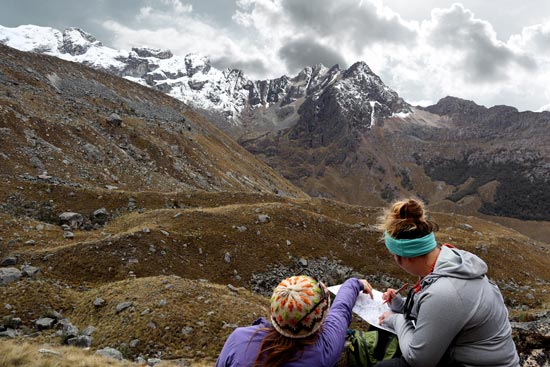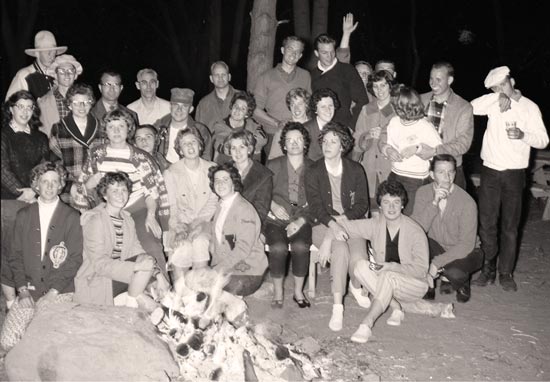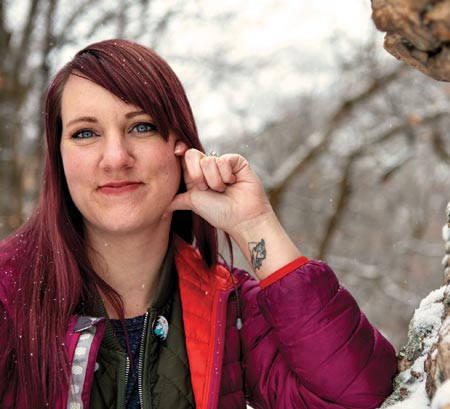Lasting Impressions

Jaime Winston, Marketing & Communications
Like a tattoo, trips to study earth’s features leave an everlasting mark on students, whether they’re to volcanic terrain and icecaps across the globe, or to our own Great Salt Lake.
As a theatre arts major and actor at the Cellar Theater, a one-time theater-in-the-round in Ogden, Doris Van De Graaff Cobb AS ’55 relished any opportunity to put on a show. Some of her most-cherished performances, though, didn’t take place on stage — they were conducted on bumpy bus rides and at rugged campsites in southern Utah. Accompanied by a friend on ukulele, Cobb recalls passing time by belting out folksy tunes like Red River Valley and She’ll Be Coming ’Round the Mountain with her classmates. On one trip, she recalls, she even learned to yodel.
The music helped set the stage for the field trips’ main attractions, Zion National Park’s vivid red canyon walls and Bryce Canyon National Park’s majestic red, white and orange rock pillars.
Cobb joined 20-plus classmates for two trips to study the geologic formations in the parks during her first and second years at Weber. Along with singing (and yodeling) partners, the trips gave her a greater understanding of Utah’s geology. “You probably heard of the cliffs falling down in Zion this year,” she said. “That’s caused from a lot of erosion, freezing and expanding, which causes the cracks to open up and chunks to fall off the mountain.”

Professor Walter Richard Buss, “Uncle Walt” as Cobb and other students affectionately called him, started taking students on trips to Zion and Bryce in 1936. Thirty-five people went on the inaugural adventure. “Out of that group of 35, there were 25 or more that had never been south of Provo,” Buss wrote in an essay published in Richard W. Sadler’s 1988 book Weber State College …A Centennial History.
The Zion-Bryce trips were a popular Weber tradition for 35 years. In fact, they were so popular that demand called for a second bus during the second year. Once, Buss recalled having to take two trips on successive weeks, and another time needing three busses for one trip.
An avid outdoorsman, Buss’s passion for the environment and geology was contagious. “His wife told me she felt like a widow sometimes because he spent so many hours in the hills studying everything,” Cobb said.
In 1946, Buss conceived a new trip idea, “College on Wheels,” teaching geology from the windows of a bus, aided by a blackboard, screen and movie projector. The first trip, he wrote, lasted 39 days and included stops at 10 national parks, along with state parks and museums. The next year, Buss and other faculty formed a new “College on Wheels,” covering 6,500 miles from Ogden to the Parícutin volcano in Mexico. “At the volcano, we walked along the edge of the flow and could feel the heat and, after dark, could see red hot rock,” Buss wrote in Sadler’s book.
Regardless of mileage or destination, Buss trips called for preparing for the unexpected. On the return trip from Dinosaur National Monument, Cobb recalled Buss adding a side trip in the Uinta Mountains, where rough terrain led to a flat tire as darkness settled in. Fortunately, Buss knew a local rancher who happened to have a spare. On a trip to Goblin Valley, Cobb said she was caught with Buss and her classmates in the worst sandstorm she ever experienced.
Whether facing storms or car trouble, Cobb said trips helped reduce the stress that came with student life. “College is pretty tough,” she said, “You’re out there to learn, but you can have a lot of fun, too.”
A Tradition Continued
Like Cobb, geology major Analeah Vaughn recalls singing with her travel mates on a Weber trip, but instead of folk songs, they sang Luis Fonsi’s 2017 hit Despacito, and instead of journeying to southern Utah, they conducted research in the Cordillera Blanca, part of the Andes, in Peru.
Along with Elizabeth Balgord, assistant professor of earth and environmental sciences, and graduates Daksha Patel BS ’17 and Carmen Longo BS ’18, Vaughn mapped rock units exposed by glacial retreat and researched the causes of water contamination in the area for a month in 2018.
She started to tear up when Balgord asked her to join the research team. “It has been my lifelong dream to travel the world and do research,” she said.
Balgord and other faculty in Weber State’s Department of Earth and Environmental Sciences keep alive Buss’s tradition of conducting fieldwork and studying the environment with students. Along with the trip to Peru, Balgord recently led students in mapping rock units at the Silver Island Mountains in Tooele County and studying geology near Moab.
“Going out in the field is the only way for them to put a lot of the pieces together that they’re learning in their classes,” Balgord said.
Along with Marek Matyjasik, professor of earth and environmental sciences and recent Fulbright Scholar to Poland, Balgord teaches the Summer Bridge Program, an intro to earth sciences for first-year students that offers a trip to Yellowstone National Park. Students in the program learn about the volcano beneath the park, what creates geysers and how the Grand Canyon of Yellowstone got its color.

Last summer, Matyjasik and Balgord took students to study another unique environment in Iceland featuring a large icecap and volcanoes. While there, they collected rock and water samples for analysis. “We look at what chemical elements and what ions are dissolving in the water and what this can tell us about where the water is coming from,” Matyjasik said.
While Iceland and Yellowstone both offered opportunities to explore unusual terrain, Matyjasik said faculty don’t have to take students more than an hour away to study a truly unique environment. Along with having eight times more salt than the ocean, the Great Salt Lake is a closed basin, meaning water can only leave through evaporation. “We know all of the water that is coming in, and it’s staying in the basin, so it’s a more complete picture,” Matyjasik said.
Carie Frantz, assistant professor of earth and environmental sciences and recipient of the 2019 Presidential Teaching Excellence Award, said her favorite place to bring students to study the lake is Ladyfinger Point, a short hike on Antelope Island’s northwest side known for striking sunsets. “There’s some really neat microbial rocks out there I like to show students,” she said. “It’s also a great vantage point to see some of the ancient shorelines from Lake Bonneville and other periods in the lake’s geologic history.”
In addition to the lake, Frantz said Weber State is situated near many spots for faculty and students to explore.
“We have all sorts of different ecosystems in this state,” she said. “Many programs don’t have the luxury of being able to just drive two hours to see world-class outcrops and rocks.”
A Lifelong Reminder

Through her trips with earth and environmental sciences faculty, near and far, Vaughn has bonded with her classmates and now sees them as family.
Before going to Peru, she mentally prepared for her first long trip away from home, being out of cell service and dealing with less oxygen at elevations over 10,000 feet. In the end, she believes she made a difference for local villagers who rely on the glacial runoff for water.
Prior to her return trip, Vaughn had a tattoo put on her wrist as a permanent reminder of her life-changing journey and what she accomplished
The design features flowers the team saw, a mountain representing one of the last valleys they visited, a semi-colon signifying both her struggles with depression and that her journey will continue, and a wave, because, according to Vaughn, “strong women make waves.”
Our Planet, Your Future
Students will have a new avenue to explore the environment when Weber State launches its Bachelor of Science in Environmental Studies in fall 2020.
The major will draw on courses and experts from each department in the College of Science to teach students to find creative solutions to complex issues related to sustainability, natural resources and ecosystem conservation. “We have a generation of students who want to be involved in problem solving,” said professor Rick Ford, who is coordinating the new major. “They are going to be the students who are interested in being broadly trained in the sciences and are interested in collaborating on interdisciplinary work.”
The Bureau of Labor Statistics projects that environmental sciences jobs will grow by 8% between 2018 and 2028, faster than the average for all occupations in the U.S., and the median annual salary is over $70,000.
The new major also complements Weber State’s focus on sustainability.
